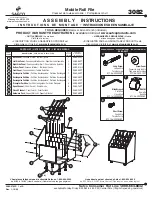
Service and Maintenance
QC620
Skid Digger
26
8. Service and Maintenance
CAUTION!
Do not risk injury by working in an unsafe
situation. Take steps to make the machine safe to
work on before performing any maintenance or
service procedure.
Follow steps listed to put the machine in a Safe
Condition.
W049
Safe Condition
1.
Rest the bucket on the ground.
2.
Turn off the hydraulic system.
3.
Apply the parking brake.
4.
Turn off the skid steer engine and remove the ignition key.
5.
Activate the hydraulic controls to relieve the pressure.
6.
Make sure all components have stopped moving.
7.
Block or chock the skid steer wheels.
8.1 Maintenance Safety
•
Read and understand all the information in the Safety
section that starts on
•
Have a minimum of two workers present when performing
maintenance on this equipment. Never work alone in case
an emergency should arise.
•
Follow good shop practices that include, but are not limited
to the following:
-
Keep the service area clean and dry.
-
Ground electrical outlets and tools correctly.
-
Make sure that there is an adequate amount of light for
the current task.
•
Never operate the tractor in a closed building. The exhaust
fumes may cause asphyxiation.
•
Never work underneath equipment unless it is securely
supported by blocks.
•
Always wear the appropriate PPE.
•
When replacement parts are required, only use genuine
original equipment manufacturer (OEM) parts. Wallenstein
Equipment cannot be held responsible for damage or
injuries that are caused by use of unapproved parts or
accessories.
•
Inspect and tighten all bolts, nuts, and screws.
•
Reinstall all safety shields and covers after completing
service or maintenance.
•
Use regular cleaners to clean parts. Do not use gasoline.
•
Always use the correct tools for the task, make sure that
the tools are in good condition, and understand how to use
them.
8.1.1 Hydraulic System Safety
•
Make sure that all the components in the hydraulic system
are kept clean and in good condition.
•
Make sure all components are tight, and that lines, hoses
and couplings are not damaged before applying pressure to
the system.
•
Do not use your hand to check for
hydraulic oil leaks. Hydraulic fluid
escaping under pressure can penetrate
the skin causing serious injury. Use a
piece of cardboard instead.
•
Wear proper hand and eye protection
when searching for a high-pressure
hydraulic leak.
•
Seek medical attention immediately if injured by a
concentrated high-pressure stream of hydraulic fluid.
Serious infection or toxic reaction can develop from
hydraulic fluid piercing the skin surface.
•
Do not attempt any makeshift repairs to the hydraulic lines,
fittings, or hoses by using tape, clamps, or cements. Doing
so can cause sudden failure and create a hazardous and
unsafe condition.
•
Relieve pressure on the hydraulic system before working
it. The hydraulic system operates under extremely high
pressure.
•
Replace any hydraulic hose immediately that shows signs
of swelling, wear, leaks, or damage before it bursts.
•
Do not bend or strike high-pressure lines, tubes or hoses,
or reinstall them in a bent or damaged condition.
•
Check to make sure hydraulic hoses are not worn or
damaged and are routed to avoid chafing.
•
Never adjust a pressure relief valve or other pressure-
limiting device to a higher pressure than specified.











































